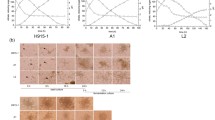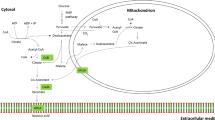Abstract
With the availability of the genome sequence of the filamentous fungus Aspergillus niger, the use of targeted genetic modifications has become feasible. This, together with the fact that A. niger is well established industrially, makes this fungus an attractive micro-organism for creating a cell factory platform for production of chemicals. Using molecular biology techniques, this study focused on metabolic engineering of A. niger to manipulate its organic acid production in the direction of succinic acid. The gene target for complete gene deletion was cytosolic ATP: citrate lyase (acl), which had previously been identified by using genome-scale stoichiometric metabolic model simulations. The acl gene was deleted using the bipartite gene-targeting method, and the mutant was characterized in batch cultivation. It was found that the succinic acid yield was increased threefold by deleting the acl gene. Additionally, the total amount of organic acids produced in the deletion strain was significantly increased. Genome-scale stoichiometric metabolic model predictions can be used for identifying gene targets. Deletion of the acl led to increased succinic acid production by A. niger.


Similar content being viewed by others
References
Baker SE (2006) Aspergillus niger genomics: past, present and into the future. Med Mycol 44:S17–S21. doi:10.1080/13693780600921037
Ballance DJ, Buxton FP, Turner G (1983) Transformation of Aspergillus nidulans by the orotidine-5′-phosphate decarboxylase gene of Neurospora crassa. Biochem Biophys Res Commun 112(1):284–289
David H, Akesson M, Nielsen J (2003) Reconstruction of the central carbon metabolism of Aspergillus niger. Eur J Biochem 270(21):4243–4253. doi:10.1046/j.1432-1033.2003.03798
Erdeniz N, Mortensen UH, Rothstein R (1997) Cloning-free PCR-based allele replacement methods. Genome Res 7(12):1174–1183. doi:10.1101/gr.7.12.1174
Ideker T, Galitski T, Hood L (2001) A new approach to decoding life: systems biology. Annu Rev Genomics Hum Genet 2:343–372
Meijer S, Panagiotou G, Olsson L, Nielsen J (2007) Physiological characterisation of xylose metabolism in Aspergillus niger under oxygen-limited conditions. Biotechnol Bioeng 98(2):462–475. doi:10.1002/bit.21397
Meyer V, Arentshorst M, El-Ghezal A, Drews AC, Kooistra R, van den Hondel CAMJ, Ram AFJ (2007) Highly efficient gene targeting in the Aspergillus niger kusA mutant. J Biotechnol 128(4):770–775. doi:10.1016/j.jbiotec.2006.12.021
Nielsen ML, Albertsen L, Lettier G, Nielsen JB, Mortensen UH (2006) Efficient PCR-based gene targeting with a recyclable marker for Aspergillus nidulans. Fungal Genet Biol 43(1):54–64. doi:10.1016/j.fgb.2005.09.005
Patil KR, Akesson M, Nielsen J (2004) Use of genome-scale microbial models for metabolic engineering. Curr Opin Biotechnol 15(1):64–69. doi:10.1016/j.copbio.2003.11.003
Pel HJ, de Winde JH, Archer DB, Dyer PS, Hofmann G, Schaap PJ, Turner G, de Vries RP, Albang R, Albermann K, Andersen MR, Bendtsen JD, Benen JAE, van den Berg M, Breestraat S, Caddick MX, Contreras R, Cornell M, Coutinho PM, Danchin EGJ, Debets AJM, Dekker P, van Dijck PWM, van Dijk A, Dijkhuizen L, Driessen AJM, d’Enfert C, Geysens S, Goosen C, Groot GSP, de Groot PWJ, Guillemette T, Henrissat B, Herweijer M, van den Hombergh JPTW, van den Hondel CAMJ, van der Heijden RTJM, van der Kaaij RM, Klis FM, Kools HJ, Kubicek CP, van Kuyk PA, Lauber J, Lu X, van der Maarel MJEC, Meulenberg R, Menke H, Mortimer MA, Nielsen J, Oliver SG, Olsthoorn M, Pal K, van Peij NNME, Ram AFJ, Rinas U, Roubos JA, Sagt CMJ, Schmoll M, Sun JB, Ussery D, Varga J, Vervecken W, de Vondervoort PJJV, Wedler H, Wosten HAB, Zeng AP, van Ooyen AJJ, Visser J, Stam H (2007) Genome sequencing and analysis of the versatile cell factory Aspergillus niger CBS 513.88. Nat Biotechnol 25(2):221–231. doi:10.1038/nbt1282
Price ND, Papin JA, Schilling CH, Palsson BO (2003) Genome-scale microbial in silico models: the constraints-based approach. Trends Biotechnol 21(4):162–169. doi:10.1016/S0167-7799(03)00030-1
Sambrook J, Russell DW (2001) Molecular cloning a laboratory manual. Cold Spring Harbor Laboratory Press, Cold Spring Harbor
Stephanopoulos G, Alper H, Moxley J (2004) Exploiting biological complexity for strain improvement through systems biology. Nat Biotechnol 22(10):1261–1267. doi:10.1038/nbt1016
Vanhartingsveldt W, Mattern IE, Vanzeijl CMJ, Pouwels PH, Vandenhondel CAMJ (1987) Development of a homologous transformation system for Aspergillus niger based on the pyrG gene. Mol Gen Genet 206(1):71–75
Acknowledgments
The study was kindly supported by The Research School for Biotechnology (FOBI), The Royal Veterinary and Agricultural University (KvL), and Novozymes funding.
Author information
Authors and Affiliations
Corresponding author
Rights and permissions
About this article
Cite this article
Meijer, S., Nielsen, M.L., Olsson, L. et al. Gene deletion of cytosolic ATP: citrate lyase leads to altered organic acid production in Aspergillus niger . J Ind Microbiol Biotechnol 36, 1275–1280 (2009). https://doi.org/10.1007/s10295-009-0607-y
Received:
Accepted:
Published:
Issue Date:
DOI: https://doi.org/10.1007/s10295-009-0607-y




